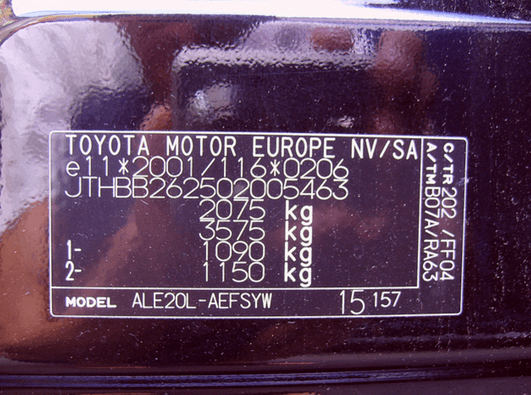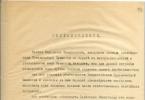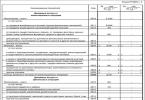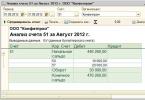A car is not a luxury, but a means of transportation - a famous character in a famous work quite rightly stated. But besides this, a car is a source of emissions of toxic compounds into the atmosphere, and therefore into the ecosystem of the country of residence. Let's talk about the environmental class of the car.
Vehicle exhaust gases are a product of combustion (oxidation) of carbon fuel. They contain both harmless or rapidly decomposing substances, as well as toxic components and carcinogens.
The first include:
- Nitrogen (N2)
- Water vapor (H2O)
- Oxygen (O2)
- Carbon monoxide (CO2)
The latter are represented by the following compounds:
- Carbon monoxide (CO)
- Hydrocarbons
- Aldehydes
- Benzpyrene
Significant increase in the concentration of toxic components and carcinogens in places of accumulation Vehicle, causes deterioration general condition human health, and increase in the number of cancer diseases.
How it all began
Due to the threatening environmental situation, in 1992, the countries of the European Union were forced to adopt a set of legislative acts regulating the content of toxic compounds in car exhaust. The first regulatory document had the collective name Euro 1. Four years later, the standards were tightened again, and the Euro 2 environmental standard was released. But this was only the beginning. Under increasing pressure from the Greens, an edition of the norms appeared 3, 4, 5.
environmental safety
On the territory of the Russian Federation, the Euro 2 standard was introduced in 2006. In 2008, Euro 3 came into force, and after another 2 years, Euro 4. It is planned that from January 2014, the Euro 5 environmental safety standard will be introduced for cars imported into the country.
What does this mean for ordinary citizens? A ban on the import of foreign-made cars whose environmental safety class does not meet the standards in force in the country.
To better understand the situation, consider the following example: On the border Russian Federation awaits Citroen 2003 release. It is certainly possible to import it into the country, but it will not be possible to register it, much less obtain a vehicle registration certificate. After all, it was manufactured when the Euro 3 standard was in force in Europe, and we already have Euro 4. Now, if the car was manufactured in 2005 or later, there will be no problems with registration, since since 2005 the European Union has adopted the Euro 4 standard.
How to find out the environmental class of a car
VIN number of the vehicle
When clearing a car or other vehicle through customs, civil servants first look at the following data and documents:
- Information in the OTTS database
- Certificate of compliance with the environmental safety standard Euro 4, and as you remember, from January 1, 2014 - Euro 5
How is the environmental class of a car determined before purchasing in order to avoid the difficulties described above? 
Using the vin number, which contains the following comprehensive information:
- Region, country and manufacturer
- Automobile model
- Body type
- Wheelbase
- Engine
- Transmission type
- Factory branch
- Serial number
Direct compliance with Euro 2, 3, 4, 5 standards is not indicated, but knowing the year of manufacture and country, determining the required environmental safety class will not be difficult. For its part, the Federal Customs Service of Russia gives everyone the opportunity to use the table of vehicle compliance with environmental standards Euro 2, 3, 4, 5 of its own design.
An exception
These standards do not apply to special equipment, upon registration of which, not a PTS, but a PSM (self-propelled mechanism passport) is issued. Required condition The maximum possible speed on a highway is 40 km/h. Officials probably believe that diesel bulldozers and excavators will not harm the ecosystem when operating within, for example, a construction site. Well, a speed of 40 km/h makes the exhaust as clean as the morning breeze. This is for units whose diesel fuel consumption is 100 liters per hour of operation.
What to expect from innovations in the new year
First of all, rising prices for secondary market foreign-made cars, an unreasonable increase in the price of outright scrap metal. And re-registration of an already imported car that meets Euro 2, 3, 4 environmental safety class standards is far from clear.
European and american cars, released no earlier than 2009. The price for them will also be appropriate.
Russia's accession to the Geneva Convention led to the introduction of regulations who set emission standards harmful substances contained in exhaust gases and falling into the air. These documents clearly state articles that indicate that only those vehicles that fully comply with European standards regarding emissions of harmful substances should be used.
Ecological car classes
After conducting a huge amount of laboratory research, data was obtained indicating that during the year the average car consumes almost 4 tons of oxygen from the environment, and after processing the following substances are released into the air:
- carbon monoxide - about 800 kg;
- carbons - 200 kg;
- nitrogen oxides - 40 kg.
If we take into account the statistics that the number of cars is increasing every day, then we can only guess what this threatens environment. Environmental services have long begun to pay attention to this issue Special attention. It is clear that it is impossible to ban the operation of cars, so it was decided to develop standards regulating the regulation of emissions of harmful substances from exhaust. All car manufacturers are required to comply with them.
What is the environmental class of a car?
This concept implies the separation of all existing cars into separate categories. Assignment to one or another category is carried out depending on the content of harmful substances in the exhaust gases. Also important is the level of harmfulness from the fumes of the fuel that is used for specific car.
Harmful fumes include:
- CO - carbon monoxide;
- NO - nitric oxide;
- hydrocarbons;
- fine solids;
Attention! The relationship of a car to the environmental class is determined at the stage of passing customs control, when the car crosses the border of the Russian Federation. Mark environmental class placed in technical passport walking with the car.

Classification of cars according to standards
Euro-1 is one of the very first standards that controls the amount of harmful components contained in exhaust gases. It applied only to vehicles equipped with a gasoline engine. The standard regulated the amount of carbon oxides, nitrogen and hydrocarbons in the exhaust. Since this was the very first standard, it is considered the most friendly to transport, but at the same time quite cruel to the environment.
Euro-2 is an already improved standard, which talks about reducing the content of harmful substances in exhaust gases by 3 times. On the territory of the Russian Federation, he entered into his legal force in 2005. Full application began only in 2006.
Euro-3 - This standard talks about the regulation of the content of negative components in the exhaust gases of a vehicle equipped not only with gasoline, but also diesel engine. The Euro 3 standard has even greater requirements for emissions. Compared to previous standards, a reduction of almost 40% is envisaged.
Euro 4 - this standard has been actively used in Europe since 2005. In Russia, it began to operate only in 2010. According to it, the reduction in the composition of negative components in exhaust gases should be 40% compared to the previous standard.
Euro 5 is one of the most popular standards used nowadays. It has become mandatory since 2008. All new heavy-duty vehicles sold in the European Union must comply with it. Correspondence passenger transport These standards have been required since 2009. In Russia, the standards were introduced in 2015.

How to find out what class a car belongs to?
There are three most the right way, thanks to which you can find out whether a vehicle belongs to the environmental class:
- analysis Vehicle title- it is quite possible that there is a mark indicating a certain standard;
- search in the Rosstandart table;
- request through the online database, indicating only the VIN.
Ecological class in PTS
First of all, you can find out which standard the car’s exhausts meet using the PTS. This is a vehicle passport containing basic technical data. If this is a new type of document, then find out necessary information possible in column 13. Most often, the class is written in words.
In the case where the document is not a new sample, this note may be in the “Additional notes” column.
Attention! If the PTS did not find an answer to this question, then you can find information in the Rosstandart table.

Ecological class in the Rosstandart table
The agency responsible for certifying vehicles, in accordance with special standards of the Russian Federation, has developed a special table with which you can find out which environmental class a car belongs to.
The main criteria that are taken into account when determining the class of a car include the year of production and the country of origin. The list of manufacturers includes not only European countries, but also those located outside of it. When compiling the table, not only the UNECE requirements were taken into account, but also other standards that are used in other producing countries.

It is surprising that Russian departments are developing this table, but our country is not on the list. The reason for this is that all the above criteria have only recently been introduced into the country. That is why it is not entirely correct to compare cars of old production and those produced in the early 2000s with cars of European production that meet all the necessary standards.
If, after you have found out the car class from the table, any unclear points or questions remain, then you can additionally find out by VIN code.
Advice! You can find the identifier in different places depending on the manufacturer: on the engine, body pillar next to the driver’s seat, on the driver’s side dashboard, under the floor trim or door sills, and always in the vehicle title.
Find out the environmental class using VIN
You can find out about the class of a vehicle by VIN code on the special website of Rosstandart. There is a special page for this on the department’s website. online service. It is through him that you can make a corresponding request.
This method has its one greatest advantage - the accuracy of the result obtained. Enter in a specific column VIN number and the request is sent. After recognizing the identifier, a result is given that describes the following data:
- car model;
- type of transport;
- approval number;
- date of issue of the document and its validity period;
- type of environmental class.
Attention! It is possible to find out the necessary information only if given VIN is in the Rosstandart database. It is quite possible that he is not there. In this case, the owner of the vehicle will have to independently contact the relevant department.

Conclusion
The introduction into force of special environmental standards regarding the content of certain harmful components contained in vehicle exhaust gases has made it possible to divide cars into environmental classes. In the case when the composition of negative substances in the exhaust is very high, the car owner will have to pay a transport tax and duty, the amount of which depends on the class.
More detailed information We will learn about the new environmental class Euro-5 in next video:
- catalyst or particulate filter
Chip tuning for Euro-0
Chip tuning for Euro-2
An example of a review of firmware with the transition to E2.
Chip tuning while maintaining toxicity standards (E4, E5, E6)
Some customers prefer to flash the ECU while maintaining factory emission standards. Often this choice is made by car owners who are under warranty at the dealer. From an environmental protection point of view, this is the most correct option. We try to stick to it.
ADACT specialists will perform a high-quality check of your car and install the firmware most suitable for a particular car.
">Chip tuning of the engine is done both while maintaining the factory Euro standards and with the transition to another standard that is less demanding in terms of emissions control.
Firmware for other Euro standards is done in 2 cases:
- The car owner has problems with the catalyst or particulate filter. On dashboard a malfunction symbol appears, and diagnostic codes P0420 and P0430 or P1447, P1448, P1901, 480A, 481A, etc.
Replacement is expensive. It is easier to remove the catalyst or particulate filter and adapt the firmware to E2/E3 standards.
- The owner wants to upgrade to a different level of environmental standard in order to increase the car's dynamics.
Let's dispel the myth that switching to another Euro standard can harm the engine. None negative consequences No. There will be one change: carbon dioxide emissions will increase with increasing dynamics.
We will get optimal quality fuel mixture, since the ECU no longer needs to worry about the safety of the catalyst or particulate filter due to radical changes in the composition of the mixture.
Chip tuning for Euro-0
Euro-0 is the oldest standard (1988). The permissible limit for carbon monoxide emissions for it is 22 times higher than for Euro-4. Firmware for this standard is rarely made. Basically, if they want a sharp increase in dynamics and are not afraid of increased fuel consumption ( sports tuning). We recommend higher standards.
Chip tuning for Euro-2
At Euro-2 with chip tuning with a change environmental standard switch most often. Emissions increase slightly, but the dynamics change dramatically in better side. Dips disappear, the cutoff shifts, power increases and even the engine sound becomes different. When switching to E2, it is necessary to remove the catalyst or particulate filter. It is important to note that there are no problems with passing the technical inspection. The transition to Euro 2 also does not affect the dealer’s warranty.
Ecological certificate Euro 2 is a set of Euro standards that limit the content of environmentally hazardous substances in vehicle exhaust gases. In the European Union, this certificate replaced the previous Euro 1 standard and was adopted in 1995. The new standard revised the standards for the emission of harmful substances into the atmosphere. Thus, the requirements for emissions of harmful substances from engines internal combustion amounted to:
CO – no more than 55 g/kWh is allowed;
CH – no more than 2.4 g/kWh is allowed;
NO – no more than 10 g/kWh is allowed.
In the Russian Federation, on October 12, 2005, the Technical Regulations “On requirements for vehicle emissions of harmful substances”, Resolution No. 609, were adopted. 6 months after official date After its publication in the press on October 21, 2005, it came into effect. This regulation contains all the norms and requirements of international environmental standards. According to the decree, from April 22, 2006, cars of a class lower than Euro 2 cannot be produced in Russia. According to the Technical Regulations, imported cars that do not have a Euro 2 certificate will be detained at the border. Whether the car complies with the Euro standard will be guaranteed by a certificate of conformity.
Information about cars will be generated by the Federal Agency for Technical Regulation and every month will be transferred to the department for ensuring safe traffic Ministry of Internal Affairs of Russia and Federal Customs Service of Russia. According to the Technical Regulations, two databases have been created that contain information about cars that comply with the Euro 2 standard and information about previously issued certificates of conformity. On the official website of Rostekhregulirovaniya, each car owner can see whether his car brand complies with the Euro 2 standard or will need to issue an appropriate Euro 2 certificate. There is also a table of compliance with standards adopted by the Ministry of Industry and Energy, which indicates which cars are prohibited for import into the territory of the Russian Federation. First of all, those who are prohibited are european cars who are over 10 years old.
A Euro 2 certificate can be issued by certified bodies that have received accreditation from Rostekhregulirovanie for the right to issue such a certificate. If the car was manufactured before 1997, then a special conclusion should be drawn up. To do this, you need to undergo an assessment of the amount of harmful substances in exhaust gases in service center. You can also obtain a certificate stating that the car has been converted and complies with the Euro 2 standard or higher. According to experts, the new Euro 2 standards may entail a reduction in the used car market by half. They believe that this will have a positive impact on the environment, because old cars emit a very large amount of harmful substances into the atmosphere. These emissions, in turn, have a negative impact on human health.
The environmental situation is getting worse every day, so you should think about it today. According to the law, all gasoline and diesel fuel must meet Euro standards. The technical regulations provided for the sale of gasoline and fuel that complies with the Euro 2 standard until December 31, 2008. For the Euro 3 standard, sales periods are limited until December 31, 2009, for the Euro 4 standard - until December 31, 2013. this moment The Russian Federation already has Euro 4 environmental standards. The government expects to switch to Euro 5 standards by 2014, when domestic producers cars will be technically ready. Euro 5 standards were already adopted in the European Union in 2009.
From Thursday, September 25, entry into the center of Moscow will be prohibited, which, according to city authorities, will reduce emissions of pollutants by 8 thousand tons per year - approximately 5%.
Agreement Concerning the Adoption of Uniform Conditions of Approval and Mutual Recognition of Approval of Equipment and Parts of Motor Vehicles (also known as the Vehicle Standardization Agreement or Geneva Agreement) was adopted on March 20, 1958 in Geneva. As part of the Agreement, more than 100 resolutions of the United Nations Economic Commission for Europe (UNECE Regulations) were adopted, ensuring road safety and environmental protection.
Countries that have acceded to the Agreement use the EEC Rules for certification tests of road vehicles. Each party has the right to adopt all or part of the rules, of which it, according to the established procedure, notifies the UNECE one year before ceasing to use a particular rule, sending a notification to the UN Secretary-General.
Among the EEC rules are the so-called European standards on pollution produced by car. According to these rules and amendments to them, there are several types of Euro standards, which differ in the maximum values of pollutants produced by road transport.
The Euro-2 standard was introduced in Europe, the USA and Japan in 1995, Euro-3 standards, which are 30 - 40% stricter than Euro-2 standards, came into force in 2000, and from January 1, 2005 it was implemented full transition to release vehicles, corresponding to Euro-4 standards, which are 65 - 70% stricter than Euro-3 levels.
In Russia, on April 22, 2006, a new technical regulations"On the requirements for emissions of pollutants from automobile equipment put into circulation on the territory of the Russian Federation." The regulation establishes that any automotive equipment put into circulation on the territory of the Russian Federation must comply with an environmental class of at least two ("Euro-2") in terms of emissions of harmful (pollutant) substances (CO, CH, NOX and dispersed particles).
By expert assessments, the Russian vehicle fleet is 90% made up of cars that meet Euro-0 standards, 5% - Euro-1, 4% - Euro-2, and only 1% of cars meet Euro-3 standards.
According to the Regulations, the technical requirements for automotive vehicles and internal combustion engines of environmental class 2 installed on them are as follows:
categories M(1), M(2) maximum weight no more than 3.5 t, N(1) with spark engines (petrol, gas) and diesel engines technical emission standards provided for by UNECE Regulation N 83-04 (emission levels B, C, D), UNECE Regulation N 24-03 with addition 1 (for diesel engines only);
categories M(1) with a maximum weight over 3.5 tons, M(2), M(3), N(1), N(2), N(3) with diesel engines and gas engines- technical emission standards provided for by UNECE Regulations No. 49-02 (emission level B), UNECE Regulations No. 24-03 with Appendix 1 (for diesel engines only);
categories M(1) with a maximum weight over 3.5 t, M(2), M(3), N(2), N(3) with gasoline engines- technical emission standards (CO - 55 g/kWh, CmHn - 2.4 g/kWh, NOX - 10 g/kWh) when tested under UNECE Regulation No. 49‑03 (ESC test cycle) .
Appendix No. 3 to the Regulations establishes the main technical requirements to fuel characteristics for automotive technology. For fuel of environmental class 2 (Euro-2) the following characteristics are established:
For gasoline - lead concentration no more than 10 mg/dm3, sulfur concentration no more than 500 mg/kg, volume fraction of benzene no more than 5%, saturated vapor pressure taking into account climatic conditions: in summer - 45 - 80 kPa, in winter period- 50 - 100 kPa;
For diesel fuel - cetane number no less than 49, density at 15C 820 - 860 kg/m3, sulfur concentration no more than 500 mg/kg, fractional composition - 95% of the volume is distilled at a temperature no more than 360C, lubricity no more than 460 microns.
On January 1, 2008, Euro-3 environmental standards came into force in Russia, prohibiting the production in the country or the import into its territory of cars that do not meet at least Euro-3 standards. From January 1, 2010, Euro-4 standards will be introduced in Russia, and from 2014 - Euro-5.



